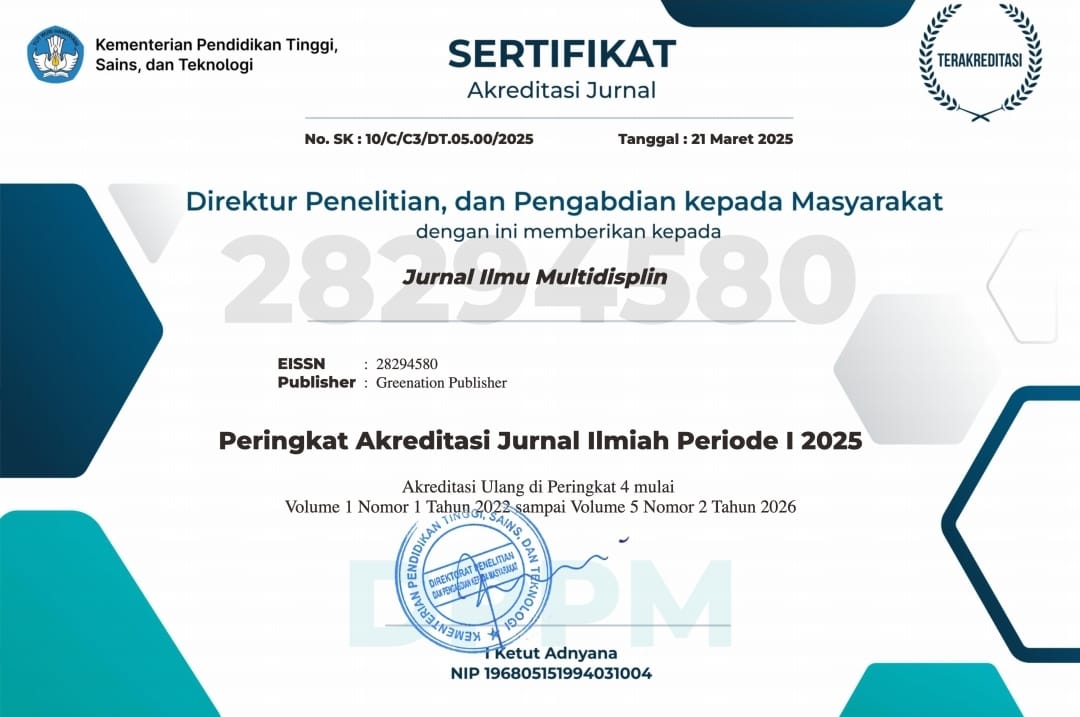The Effectiveness of the ODOW Strategy in Developing Young Learners’ English Vocabulary
DOI:
https://doi.org/10.38035/jim.v4i4.1303Keywords:
Young learner, English vocabulary, ODOW strategyAbstract
This study investigated the effectiveness of the One Day One Word (ODOW) strategy to enhance English as a Foreign Language (EFL) vocabulary mastery among elementary school students. This classroom action research (CAR) involved sixty-three fourth-grade students as research subjects. The preliminary test revealed that 57 out of 63 subjects struggled with basic vocabulary translation from Indonesian to English, scoring below 75 out of 100 on items taken directly from their textbook. The research proceeded with a cyclical approach consisting of four key stages: planning, action, observation, and reflection The initial results from Cycle 1 demonstrated some improvement, with 41 out of 63 students achieving an average score of 70 out of 100. Then, this research implemented cycle 2. The results of cycle 2 were significantly more promising, with 60 out of 63 students achieving an average score of 91 out of 100. The findings showed that the ODOW strategy was beneficial for improving young learners’ vocabulary mastery in an EFL context. In addition, the findings indicated that consistent, focused exposure to new vocabulary, coupled with active engagement and practice, could lead to significant gains in vocabulary acquisition.
References
Blachowicz, C. L., & Fisher, P. (2006). Teaching Vocabulary in All Classroom. Colombus: OH.
Cohen L., Manion L., & Morrison, K. (2018). Research Method in Education (8th Edition). New York: Routledge.
Dewi, E. Z. P. (2016). The Effectiveness of Using One Day One Word Strategy towards Vocabulary Mastery of Eight Grade Students of Islamic Junior High School 2 of Blitar [Undergraduate Thesis]. UIN Sayyid Ali Rahmatullah Tulungagung. http://repo.uinsatu.ac.id/6961/.
Dewi, E. Z. P., Ngaisah, S., Hira, S., Muliawan, A. A., & Darmanto, D. (2025). Grammatical omission in English descriptive texts: Insights from second semester EFL learners. KAPALAMADA: Jurnal Multidisipliner, 4(2), 59–72. https://doi.org/10.62668/kapalamada.v4i02.1672
Feranty, L., Anggreini, M., Meylani, & Darmawan, I. P. (2024). Improving fifth-grade students’ vocabulary mastery using flashcards: A classroom action research. Journal of English Teaching, 10(1), 51–60. https://doi.org/10.33541/jet.v10i1.5483.
Fitria, R., & Pangesti, A. P. (2023). Parental Involvement During Online Learning: A Study Among Low-Income Families in Indonesia. Jurnal ilmiah sekolah dasar, 7(1), 67-75. https://doi.org/10.23887/jisd.v7i1.54006.
Hestiana M., & Anita, A. (2022). The Role of Movie Subtitles to Improve Students’ Vocabulary. Journal of English Language Teaching and Learning, 3(1), 46-53.
Mokalu, P. V.V. (2022). The Use of Realia to Improve Young Learners’ Vocabulary. Journal of English Language Teaching, Literature and Culture 1(1), 46-53. https://download.garuda.kemdikbud.go.id/article.php?article=3297971.
Kim, T. P. (2023). Reviewing the significance of practice in learning English as a second language: Challenges, impacts, and strategies. Journal of Knowledge Learning and Science Technology 2(2), 62-67. https://doi.org/10.60087/jklst.vol2.n2.p.67.
Liando, N. V. F., Tatipang, D. P., Tamboto, G., Poluan, M., & Manuas, M. (2022). Pictures as a Learning Media in Teaching Vocabulary. Jurnal Ilmiah Universitas Batanghari Jambi, 22(3), 1944-1949. DOI: http://dx.doi.org/10.33087/jiubj.v22i3.2832.
Lutfiana, E. (2021). The difficulties faced by foreigners in learning Indonesian at Puri Bahasa Indonesia. JLA: Jurnal Lingua Applicata, 4(2), 89-98. https://doi.org/10.22146/jla.58394.
Lutfiyah, N., Nuraeningsih, N., & Rusiana, R. (2022). The obstacles in learning vocabulary of EFL students. Prominent: Journal of English Studies, 5(2), 114-125. https://jurnal.umk.ac.id/index.php/Pro.
Naderiheshi, A. (2022). Review of Literature on Teaching English Vocabularies Through Games to Young Language Learners. Journal of Language Teaching and Research, 13(1), 12-19. https://doi.org/10.17507/jltr.1301.02.
Pangesti, A. W., Nurdiana, N., & Kadaryanto, B. (2022). EFL classrooms in the Indonesian context: How do eleventh-grade students perceive rewards in EFL instruction. Asian Journal of Multilingualism and Applied Linguistics, 1(2), 3034. https://doi.org//10.53402/ajmal.v1i3.70.
Putra, R.W.P. (2023). Improving Students’ Vocabulary through Paper-Mode Quizizz: A Classroom Action Research in Indonesian EFL Setting. English Learning Innovation, 4(1), 22-31. https://doi.org/10.22219/englie.v4il.22513.
Putri, E., & Education, E. (2022). An Impact of the Use Instagram Application towards Students Vocabulary. Jurnal Pustaka Ilmu, 2(2), 1-10.
Rohmatillah, N., Musmulyadin, M., Maharaja c. H., Sabri, S., & Ulwi, K. (2023). The impact of parental involvement in online learning on students’ academic success. JCSA: Journal of Computer Science Advancements, 2(1), 45–52. https://doi.org/10.70177/jsca.v1i6.926.
Rowiyah, S., Fitriani, A., & Anam, K. (2024). Parental involvement in young learners’ speaking: A qualitative study on learner performance and classroom instruction. JOLLT: Journal of Languages and Language Teaching, 12(4), 1705–1720. https://doi.org/10.33394/jollt.v12i4.12173.
Sanjaya. I. G. H., Ni Luh P. E. S., & Anak, G. A. G. (2022). An Investigation of Teaching Aids Used by English Teachers in Teaching Vocabulary for Young Learners. Journal of Education, 26-34. DOI: 10.36663/joes.v2i1.227.
énéchal, M., & LeFevre, J. (2014). Continuity and change in the home literacy environment as predictors of growth in vocabulary and reading. Child Development, 85(4), 1552–1568. https://doi.org/10.1111/cdev.12222.
Sitorus, J. S. (2021). Improving students’ vocabulary acquisition through classroom action research [Bachelor’s thesis]. Universitas Islam Negeri Sumatera Utara. http://repository.uinsu.ac.id/11786/1/SKRIPSI%20%20JESI%20SURYANI%20SITORUS.pdf
Sumarni, B., Bhatta, D. D., & Kho, S. F. (2022). The Use of Total Physical Response in Teaching Vocabulary Integrated with Meaningful Classroom Interaction. Journal of Language and Literature Studies 2(1), 23-32. https://doi.org/10.36312/jolls.v2i1.710.
Umroh, S., Rismiyanto, & Ismaya, E. A. (2024). The effect of using WhatsApp Group and Google Classroom platforms for interests and learning outcomes of fourth grade students. ICCCM Journal of Social Sciences and Humanities, 3(1), 30–36. https://doi.org/10.53797/icccmjssh.v3i1.5.2024.
Wasik, B. A., & Hindman, A. H. (2020). Strengthening vocabulary in early childhood: Parents and teachers as partners. The Reading Teacher, 73(4), 461–470. https://eric.ed.gov/?id=ED611720.
Weerasinghe, M., Biener, V., Grubert, J., Quigley, A. J., Toniolo, A., Pucihar, K. ?., & Kljun, M. (2022). VocabulARy: Learning vocabulary in AR supported by keyword visualisations. ArXiv. https://arxiv.org/abs/2207.00896.
Yoong, Y. Y., Kaur, S., & Keat, P. H. (2019). Constructivist learning, vocabulary learning strategies and motivational theories for English vocabulary acquisition tool using cloud computing. International Journal of Academic Research in Business and Social Sciences, 9(13), 304-318. DOI:10.6007/IJARBSS/v9-i14/6871.
Yudha, H. T., & Berlinda. M. (2021). The Analysis of Game Usage for Senior High School Students to Improve Their Vocabulary Mastery. Journal of English Language Teaching and Learning, 2(2), 74-79. http://jim.teknokrat.ac.id/index.php/english-language-teaching/index.
Zarfsaz, E., & Yeganehpour, P. (2021). The Impact of Different Context Levels on Vocabulary Learning and Retention. Shanlax International Journal of Education, 9(4), 24-34. http://www.shanlaxjournals.in/journals/index.php/education.
Downloads
Published
How to Cite
Issue
Section
License
Copyright (c) 2025 Ekka Zahra Puspita Dewi, Siti Ngaisah, salma Hira, darmanto darmanto

This work is licensed under a Creative Commons Attribution 4.0 International License.
You are free to:
- Share— copy and redistribute the material in any medium or format
- Adapt— remix, transform, and build upon the material for any purpose, even commercially.
The licensor cannot revoke these freedoms as long as you follow the license terms.
Under the following terms:
- Attribution— You must give appropriate credit, provide a link to the license, and indicate if changes were made. You may do so in any reasonable manner, but not in any way that suggests the licensor endorses you or your use.
- No additional restrictions— You may not apply legal terms or technological measures that legally restrict others from doing anything the license permits.
Notices:
- You do not have to comply with the license for elements of the material in the public domain or where your use is permitted by an applicable exception or limitation.
- No warranties are given. The license may not give you all of the permissions necessary for your intended use. For example, other rights such as publicity, privacy, or moral rightsmay limit how you use the material.




























